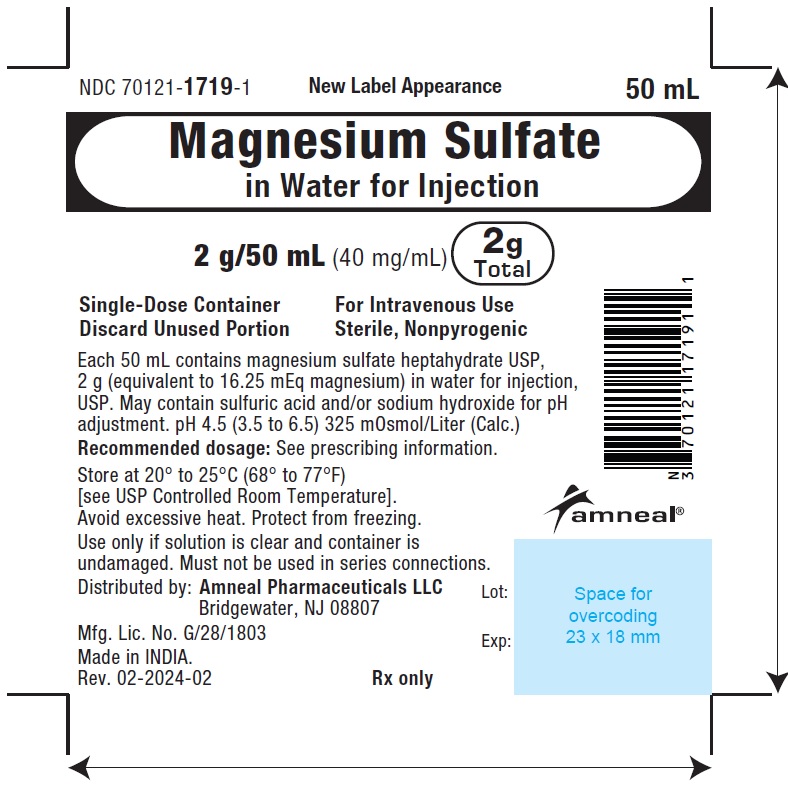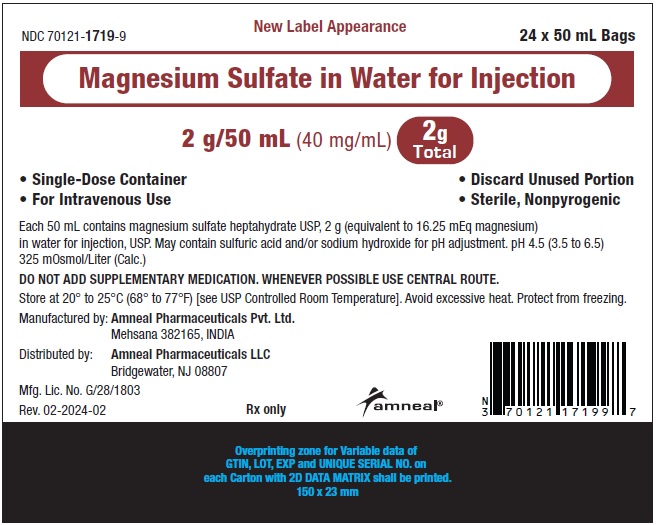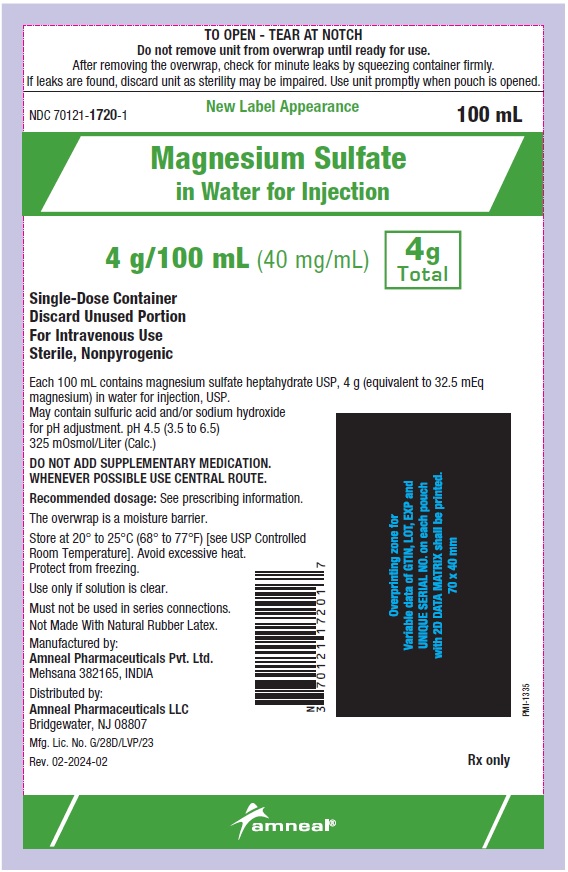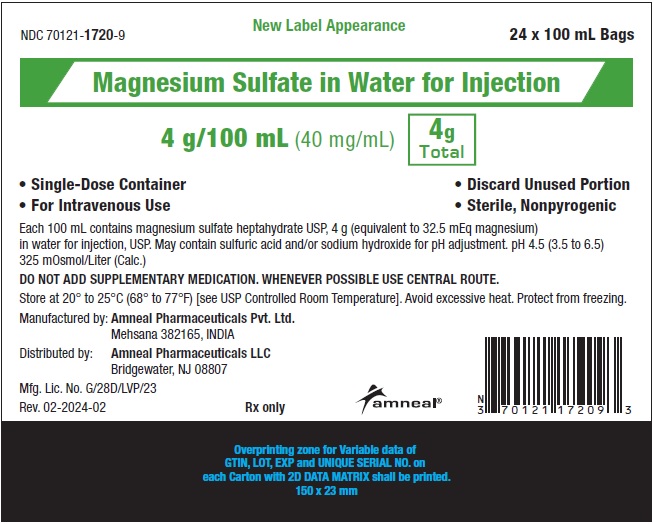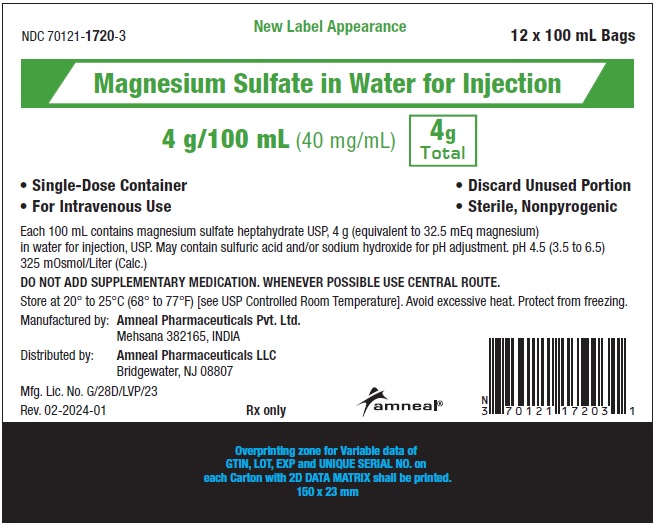Label: MAGNESIUM SULFATE- magnesium sulfate in water for injection
- NDC Code(s): 70121-1719-2, 70121-1719-9, 70121-1720-3, 70121-1720-9
- Packager: Amneal Pharmaceuticals LLC
- Category: HUMAN PRESCRIPTION DRUG LABEL
- DEA Schedule: None
- Marketing Status: Abbreviated New Drug Application
Drug Label Information
Updated April 19, 2024
If you are a consumer or patient please visit this version.
- Download DRUG LABEL INFO: PDF XML
- Official Label (Printer Friendly)
-
DESCRIPTION
Magnesium sulfate in water for injection is a sterile, nonpyrogenic, clear and colorless solution of magnesium sulfate heptahydrate, USP in water for injection, USP. May contain sulfuric acid and/or sodium hydroxide for pH adjustment. The pH is 4.5 (3.5 to 6.5). It is available in 4% concentration. See HOW SUPPLIED section for the content and characteristics of available dosage forms and sizes.
Magnesium sulfate heptahydrate is chemically designated as MgSO4 • 7H2O and its molecular weight is 246.5 g/mol and having below structural formula:
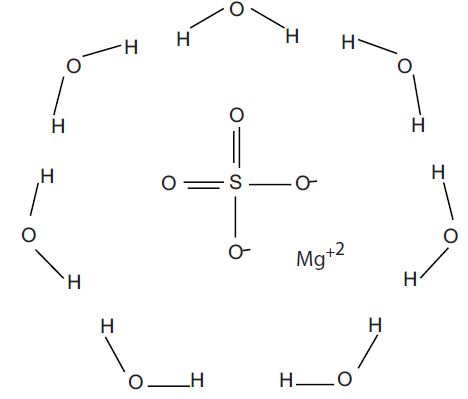
Magnesium sulfate heptahydrate, USP is white or almost white crystalline powder or brilliant colorless crystals which is freely soluble in water, very soluble in boiling water, practically insoluble in ethanol (96%).
Water for Injection, USP is chemically designated H2O.
The flexible plastic container is fabricated from a specially formulated non polyvinylchloride.
-
CLINICAL PHARMACOLOGY
Magnesium (Mg++) is an important cofactor for enzymatic reactions and plays an important role in neurochemical transmission and muscular excitability.
Magnesium prevents or controls convulsions by blocking neuromuscular transmission and decreasing the amount of acetylcholine liberated at the end plate by the motor nerve impulse. Magnesium is said to have a depressant effect on the central nervous system, but it does not adversely affect the mother, fetus or neonate when used as directed in eclampsia or pre-eclampsia. Normal serum magnesium levels range from 1.3 mEq/liter to 2.1 mEq/liter.
As serum magnesium rises above 4 mEq/liter, the deep tendon reflexes are first decreased and then disappear as the serum level approaches 10 mEq/liter. At this level respiratory paralysis may occur. Heart block also may occur at this or lower serum levels of magnesium.
Magnesium acts peripherally to produce vasodilation. With low doses only flushing and sweating occur, but larger doses cause lowering of blood pressure. The central and peripheral effects of magnesium poisoning are antagonized to some extent by intravenous administration of calcium.
With intravenous administration the onset of anticonvulsant action is immediate and lasts about 30 minutes. Following intramuscular administration the onset of action occurs in about one hour and persists for three to four hours. Effective anticonvulsant serum levels range from 2.5 mEq/liter to 7.5 mEq/liter.
Pharmacokinetics:
Absorption: Intravenously administered magnesium is immediately absorbed.
Distribution: Approximately 1% to 2% of total body magnesium is located in the extracellular fluid space. Magnesium is 30% bound to albumin.
Metabolism: Magnesium is not metabolized.
Excretion: Magnesium is excreted solely by the kidney at a rate proportional to the serum concentration and glomerular filtration.
Special Populations:
Renal Insufficiency: Magnesium is excreted solely by the kidney. In patients with severe renal insufficiency, the dose should be lower and frequent serum magnesium levels must be obtained (see DOSAGE AND ADMINISTRATION).
Hepatic Insufficiency: Magnesium is excreted solely by the kidney. No dosing adjustments are necessary in hepatic insufficiency.
Drug-Drug Interactions: Drug induced renal losses of magnesium occur with the following drugs or drug classes:
Aminoglycosides
Cyclosporine
Digitalis
Alcohol
Amphotericin B
Diuretics
Cisplatin
-
INDICATIONS AND USAGE
Magnesium sulfate in water for injection is indicated for the prevention and control of seizures in preeclampsia and eclampsia, respectively. When used judiciously it effectively prevents and controls the convulsions of eclampsia without producing deleterious depression of the central nervous system of the mother or infant. However, other effective drugs are available for this purpose.
- CONTRAINDICATIONS
-
WARNINGS
FETAL HARM: Continuous administration of magnesium sulfate beyond 5 to 7 days to pregnant women can lead to hypocalcemia and bone abnormalities in the developing fetus. These bone abnormalities include skeletal demineralization and osteopenia. In addition, cases of neonatal fracture have been reported. The shortest duration of treatment that can lead to fetal harm is not known. Magnesium sulfate should be used during pregnancy only if clearly needed. If magnesium sulfate is given for treatment of preterm labor, the woman should be informed that the efficacy and safety of such use have not been established and that use of magnesium sulfate beyond 5 to 7 days may cause fetal abnormalities.
Parenteral use in the presence of renal insufficiency may lead to magnesium intoxication.
-
PRECAUTIONS
Because magnesium is removed from the body solely by the kidneys, the drug should be used with caution in patients with renal impairment. Urine output should be maintained at a level of 100 mL every four hours. Monitoring serum magnesium levels and the patient’s clinical status is essential to avoid the consequences of overdosage in toxemia. Clinical indications of a safe dosage regimen include the presence of the patellar reflex (knee jerk) and absence of respiratory depression (approximately 16 breaths or more/minute). Serum magnesium levels usually sufficient to control convulsions range from 3 to 6 mg/100 mL (2.5 mEq/liter to 5 mEq/liter). The strength of the deep tendon reflexes begins to diminish when serum magnesium levels exceed 4 mEq/liter. Reflexes may be absent at 10 mEq magnesium/liter, where respiratory paralysis is a potential hazard. An injectable calcium salt should be immediately available to counteract the potential hazards of magnesium intoxication in eclampsia.
Magnesium sulfate in water for injection should be administered slowly to avoid producing hypermagnesemia.
Carcinogenesis, Mutagenesis, Impairment of Fertility: Studies with Magnesium sulfate in water for injection have not been performed to evaluate carcinogenic potential, mutagenic potential or effects on fertility.
Teratogenic Effects:
Magnesium sulfate in water for injection, can cause fetal abnormalities when administered beyond 5 to 7 days to pregnant women. There are retrospective epidemiological studies and case reports documenting fetal abnormalities such as hypocalcemia, skeletal demineralization’s, osteopenia and other skeletal abnormalities with continuous maternal administration of magnesium sulfate for more than 5 to 7 days1 to 12. Magnesium sulfate in water for injection should be used during pregnancy only if clearly needed. If this drug is used during pregnancy the woman should be apprised of the potential harm to the fetus.
Nonteratogenic Effects:
When administered by continuous intravenous infusion (especially for more than 24 hours preceding delivery) to control convulsions in a toxemic woman, the newborn may show signs of magnesium toxicity, including neuromuscular or respiratory depression (see OVERDOSAGE).
Labor and Delivery:
Continuous administration of magnesium sulfate is an unapproved treatment for preterm labor. The safety and efficacy of such use have not been established. The administration of Magnesium sulfate in water for injection outside of its approved indication in pregnant women should be by trained obstetrical personnel in a hospital setting with appropriate obstetrical care facilities.
Nursing Mothers:
It is not known whether this drug is excreted in human milk. Because many drugs are excreted in human milk, caution should be exercised when Magnesium sulfate in water for injection is administered to a nursing mother.
-
ADVERSE REACTIONS
The adverse effects of parenterally administered magnesium usually are the result of magnesium intoxication. These include flushing, sweating, hypotension, depressed reflexes, flaccid paralysis, hypothermia, circulatory collapse, cardiac and central nervous system depression proceeding to respiratory paralysis.
Hypocalcemia with signs of tetany secondary to magnesium sulfate therapy for eclampsia has been reported.
-
OVERDOSAGE
Magnesium intoxication is manifested by a sharp drop in blood pressure and respiratory paralysis. Disappearance of the patellar reflex is a useful clinical sign to detect the onset of magnesium intoxication. In the event of overdosage, artificial ventilation must be provided until a calcium salt can be injected intravenous to antagonize the effects of magnesium.
For Treatment of Overdose
Artificial respiration is often required. Intravenous calcium, 10 mL to 20 mL of a 5% solution (diluted if desirable) with isotonic sodium chloride for injection) is used to counteract effects of hypermagnesemia. Subcutaneous physostigmine, 0.5 mg to 1 mg may be helpful.
Hypermagnesemia in the newborn may require resuscitation and assisted ventilation via endotracheal intubation or intermittent positive pressure ventilation as well as intravenous calcium.
-
DOSAGE AND ADMINISTRATION
Magnesium sulfate in water for injection is intended for intravenous use only. For the management of pre-eclampsia or eclampsia, intravenous infusions of dilute solutions of magnesium (1% to 8%) are often given in combination with intramuscular injections of 50% Magnesium Sulfate Injection, USP. Therefore, in the clinical conditions cited below, both forms of therapy are noted, as appropriate. Continuous maternal administration of magnesium sulfate in pregnancy beyond 5 to 7 days can cause fetal abnormalities.
In Eclampsia
In severe pre-eclampsia or eclampsia, the total initial dose is 10 g to 14 g of magnesium sulfate. To initiate therapy, 4 g of Magnesium sulfate in water for injection may be administered intravenously. The rate of intravenous infusion should generally not exceed 150 mg/minute, or 3.75 mL of a 4% concentration (or its equivalent) per minute, except in severe eclampsia with seizures. Simultaneously, 4 g to 5 g (32.5 mEq to 40.6 mEq) of magnesium sulfate may be administered intramuscularly into each buttock using undiluted 50% Magnesium Sulfate Injection, USP. After the initial intravenous dose, some clinicians administer 1 g/hour to 2 g/hour by constant intravenous infusion.
Subsequent intramuscular doses of 4 g to 5 g of magnesium sulfate may be injected into alternate buttocks every four hours, depending on the continuing presence of the patellar reflex, adequate respiratory function, and absence of signs of magnesium toxicity. Therapy should continue until paroxysms cease.
A serum magnesium level of 6 mg/100 mL is considered optimal for control of seizures. A total daily (24 hr) dose of 30 g to 40 g magnesium sulfate should not be exceeded. In the presence of severe renal insufficiency, frequent serum magnesium concentrations must be obtained and the maximum dosage of magnesium sulfate is 20 g per 48 hours.
Parenteral drug products should be inspected visually for particulate matter and discoloration prior to administration, whenever solution and container permit.
Do not administer unless solution is clear. Discard unused portion.
-
HOW SUPPLIED
Magnesium Sulfate in Water for Injection is clear and colorless solution filled in intravenous bag and are supplied as 2 g/50 mL (40 mg/mL) and 4 g/100 mL (40 mg/mL). Each 50 mL contains 2 g of magnesium sulfate heptahydrate, USP (equivalent to 16.25 mEq magnesium) in water for injection and each 100 mL contains 4 g of magnesium sulfate heptahydrate, USP (equivalent to 32.5 mEq magnesium) in water for injection. It is available as follows:
Strength
Each
Unit of Sale
2 g/50 mL (40 mg/mL)
NDC 70121-1719-1
1 Single-dose Intravenous Bag in an Overwrap
NDC 70121-1719-9
Unit of 24
NDC 70121-1719-2
Unit of 154 g/100 mL (40 mg/mL)
NDC 70121-1720-1
1 Single-dose Intravenous Bag in an Overwrap
NDC 70121-1720-9
Unit of 24
NDC 70121-1720-3
Unit of 12For more details, please see below table:
NDC No.
Size
Total Magnesium Sulfate
Total Magnesium Ion
Magnesium Sulfate Concentration
Magnesium Ion Concentration
Osmolarity
(cal.)
70121-1719-1
50 mL
2 g
16.25 mEq
40 mg/mL
16.25 mEq/50 mL
325 mOsmol/Liter
70121-1720-1
100 mL
4 g
32.5 mEq
40 mg/mL
32.5 mEq/100 mL
325 mOsmol/Liter
WARNING: DO NOT USE FLEXIBLE CONTAINER IN SERIES CONNECTIONS.
Store at 20° to 25°C (68° to 77°F) [see USP Controlled Room Temperature]. Avoid excessive heat. Protect from freezing.
-
REFERENCES
- Yokoyama K, Takahashi N, Yada Y. Prolonged maternal magnesium administration and bone metabolism in neonates. Early Human Dev. 2010; 86(3):187-91. Epub 2010 Mar 12.
- Wedig KE, Kogan J, Schorry EK et al. Skeletal demineralization and fractures caused by fetal magnesium toxicity. J Perinatol. 2006; 26(6):371-4.
- Nassar AH, Sakhel K, Maarouf H, et al. Adverse maternal and neonatal outcome of prolonged course of magnesium sulfate tocolysis. Acta Obstet Gynecol Scan. 2006;85(9):1099-103.
- Malaeb SN, Rassi A, Haddad MC. Bone mineralization in newborns whose mothers received magnesium sulphate for tocolysis of premature labor. Pediatr Radiol. 2004;34(5):384-6. Epub 2004 Feb 18.
- Matsuda Y, Maeda Y, Ito M, et al. Effect of magnesium sulfate treatment on neonatal bone abnormalities. Gynecol Obstet Invest. 1997; 44(2):82-8.
- Schanler RJ, Smith LG, Burns PA. Effects of long-term maternal intravenous magnesium sulfate therapy on neonatal calcium metabolism and bone mineral content. Gynecol Obstet Invest. 1997; 43(4):236-41.
- Santi MD, Henry GW, Douglas GL. Magnesium sulfate treatment of preterm labor as a cause of abnormal neonatal bone mineralization. J Pediatr Orthop. 1994; 14(2):249-53.
- Holocomb WL, Shackelford GD, Petrie RH. Magnesium tocolysis and neonatal bone abnormalities: a controlled study. Obstet Gynecol. 1991; 78(4):611-4.
- Cumming WA, Thomas VJ. Hypermagnesemia: a cause of abnormal metaphyses in the neonate. Am J Roentgenol. 1989; 152(5):1071-2.
- Lamm CL, Norton KL, Murphy RJ. Congenital rickets associated with magnesium sulfate infusion for tocolysis. J Pediatr. 1988; 113(6):1078-82.
- McGuinness GA, Weinstein MM, Cruikshank DP, et al. Effects of magnesium sulfate treatment on perinatal calcium metabolism. II. Neonatal responses. Obstet Gynecol. 1980;56(5):595-600.
- Riaz M, Porat R, Brodsky NL, et al. The effect of maternal magnesium sulfate treatment on newborns: a prospective controlled study. J Perinatol. 1998; 18(6 pt 1):449-54.
To report SUSPECTED ADVERSE REACTIONS, contact Amneal Pharmaceuticals at 1-877-835-5472 or FDA at 1-800-FDA-1088 or www.fda.gov/medwatch.
Manufactured by:

Amneal Pharmaceuticals Pvt. Ltd.
Mehsana 382165, INDIA
Distributed by:
Amneal Pharmaceuticals LLC
Bridgewater, NJ 08807
Rev. 02-2024-03
-
PRINCIPAL DISPLAY PANEL
NDC 70121-1719-1
Magnesium Sulfate in Water for Injection
2 g/50 mL (40 mg/mL)
Intravenous Bag Label
Rx only
Amneal Pharmaceuticals LLC
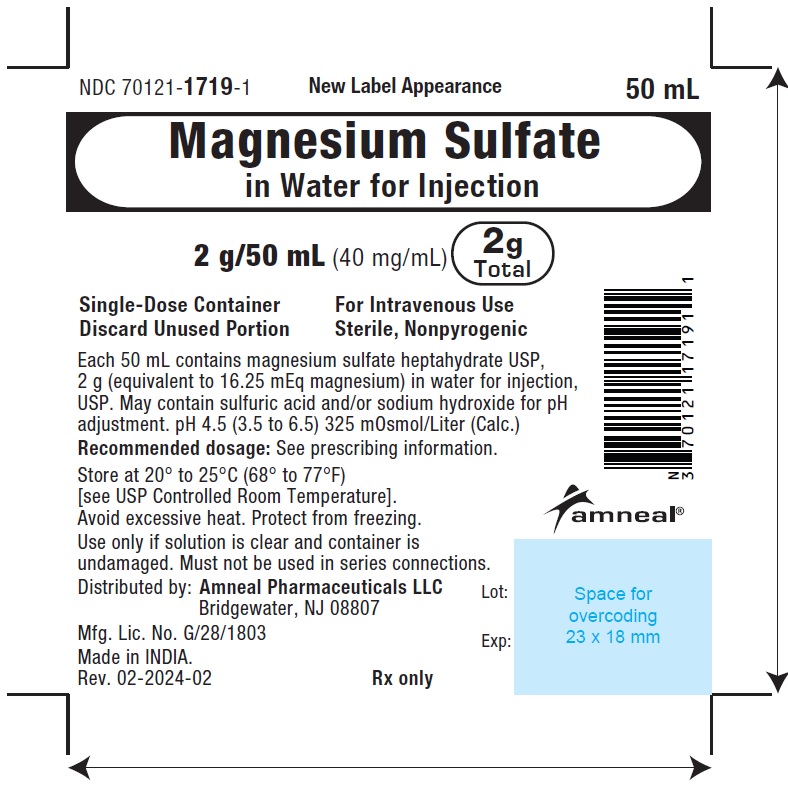
NDC 70121-1719-1
Magnesium Sulfate in Water for Injection
2 g/50 mL (40 mg/mL)
Pouch Label
Rx only
Amneal Pharmaceuticals LLC
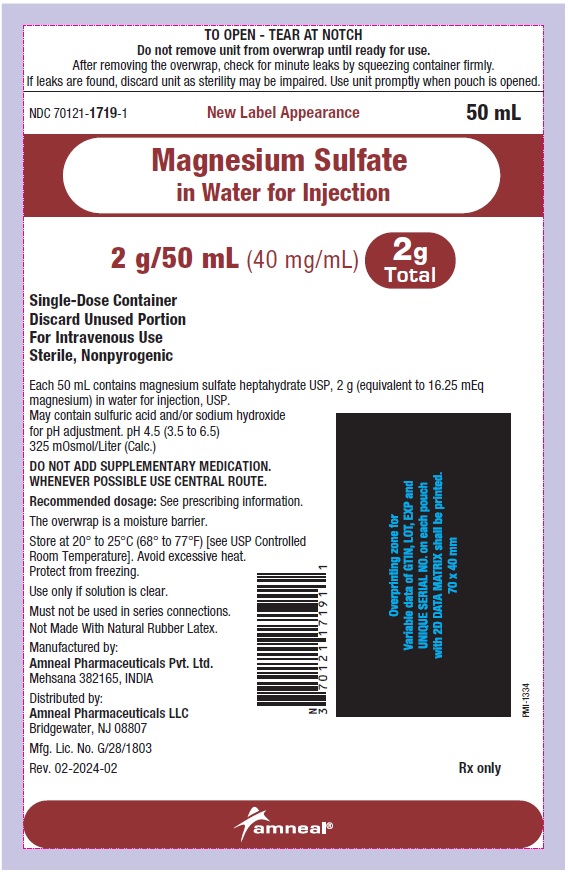
NDC 70121-1719-9
Magnesium Sulfate in Water for Injection
2 g/50 mL (40 mg/mL)
24 x 50 mL Carton Label
Rx only
Amneal Pharmaceuticals LLC

NDC 70121-1719-2
Magnesium Sulfate in Water for Injection
2 g/50 mL (40 mg/mL)
15 x 50 mL Carton Label
Rx only
Amneal Pharmaceuticals LLC
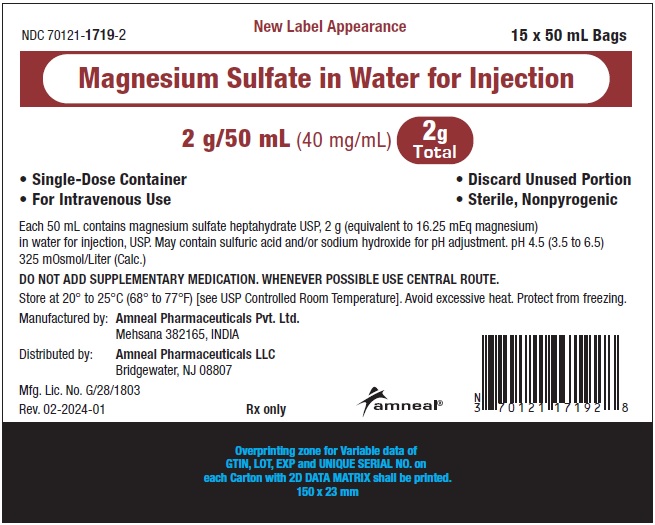
NDC 70121-1720-1
Magnesium Sulfate in Water for Injection
4 g/100 mL (40 mg/mL)
Intravenous Bag Label
Rx only
Amneal Pharmaceuticals LLC
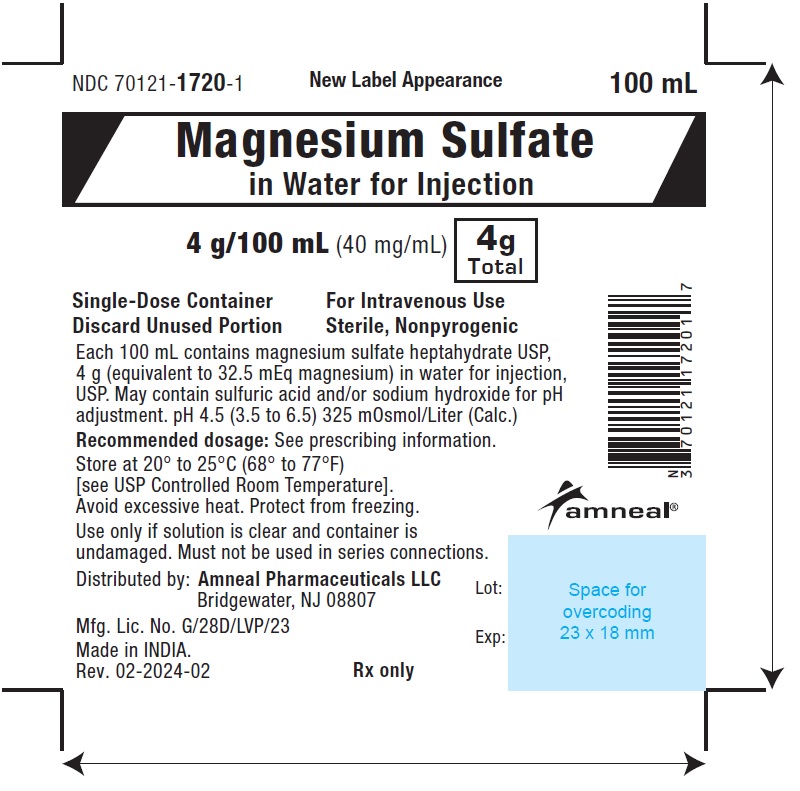
NDC 70121-1720-1
Magnesium Sulfate in Water for Injection
4 g/100 mL (40 mg/mL)
Pouch Label
Rx only
Amneal Pharmaceuticals LLC
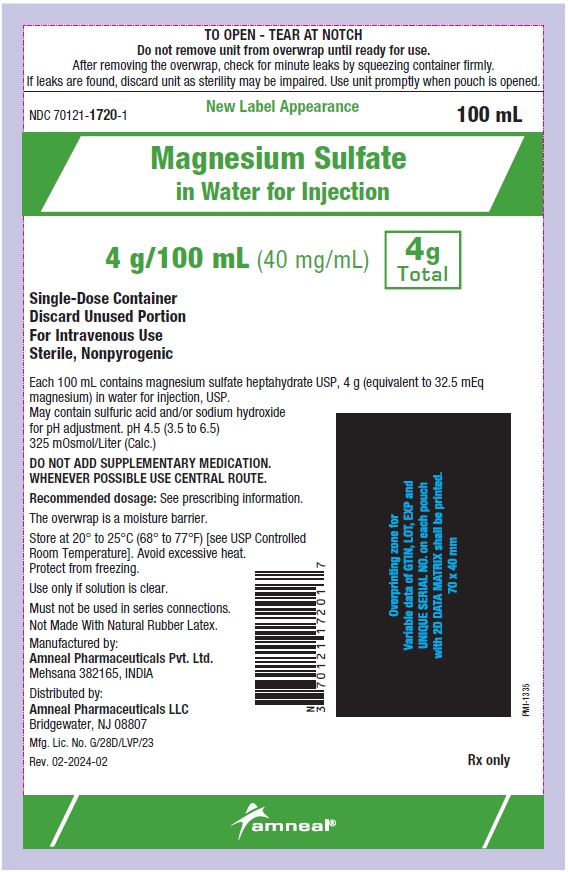
NDC 70121-1720-9
Magnesium Sulfate in Water for Injection
4 g/100 mL (40 mg/mL)
24 x 100 mL Carton Label
Rx only
Amneal Pharmaceuticals LLC

NDC 70121-1720-3
Magnesium Sulfate in Water for Injection
4 g/100 mL (40 mg/mL)
12 x 100 mL Carton Label
Rx only
Amneal Pharmaceuticals LLC
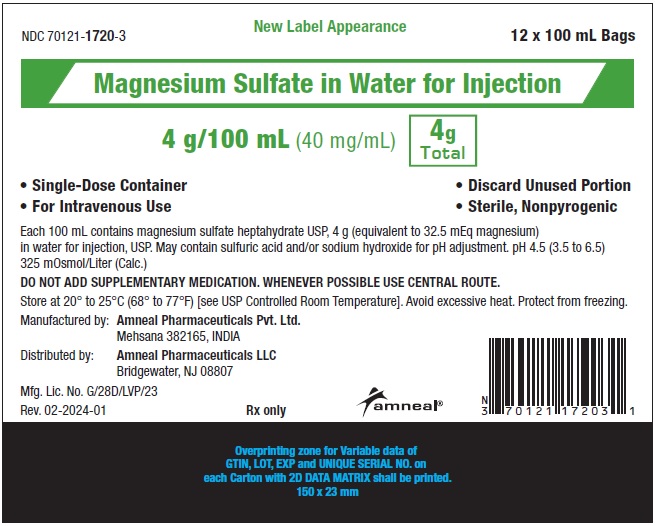
-
INGREDIENTS AND APPEARANCE
MAGNESIUM SULFATE
magnesium sulfate in water for injectionProduct Information Product Type HUMAN PRESCRIPTION DRUG Item Code (Source) NDC:70121-1719 Route of Administration INTRAVENOUS Active Ingredient/Active Moiety Ingredient Name Basis of Strength Strength MAGNESIUM SULFATE HEPTAHYDRATE (UNII: SK47B8698T) (MAGNESIUM CATION - UNII:T6V3LHY838) MAGNESIUM SULFATE HEPTAHYDRATE 40 mg in 1 mL Inactive Ingredients Ingredient Name Strength SODIUM HYDROXIDE (UNII: 55X04QC32I) SULFURIC ACID (UNII: O40UQP6WCF) WATER (UNII: 059QF0KO0R) Packaging # Item Code Package Description Marketing Start Date Marketing End Date 1 NDC:70121-1719-9 24 in 1 CARTON 02/20/2023 1 1 in 1 POUCH 1 50 mL in 1 BAG; Type 2: Prefilled Drug Delivery Device/System (syringe, patch, etc.) 2 NDC:70121-1719-2 15 in 1 CARTON 01/08/2024 2 1 in 1 POUCH 2 50 mL in 1 BAG; Type 2: Prefilled Drug Delivery Device/System (syringe, patch, etc.) Marketing Information Marketing Category Application Number or Monograph Citation Marketing Start Date Marketing End Date ANDA ANDA216597 02/20/2023 MAGNESIUM SULFATE
magnesium sulfate in water for injectionProduct Information Product Type HUMAN PRESCRIPTION DRUG Item Code (Source) NDC:70121-1720 Route of Administration INTRAVENOUS Active Ingredient/Active Moiety Ingredient Name Basis of Strength Strength MAGNESIUM SULFATE HEPTAHYDRATE (UNII: SK47B8698T) (MAGNESIUM CATION - UNII:T6V3LHY838) MAGNESIUM SULFATE HEPTAHYDRATE 40 mg in 1 mL Inactive Ingredients Ingredient Name Strength SODIUM HYDROXIDE (UNII: 55X04QC32I) SULFURIC ACID (UNII: O40UQP6WCF) WATER (UNII: 059QF0KO0R) Packaging # Item Code Package Description Marketing Start Date Marketing End Date 1 NDC:70121-1720-9 24 in 1 CARTON 02/20/2023 1 1 in 1 POUCH 1 100 mL in 1 BAG; Type 2: Prefilled Drug Delivery Device/System (syringe, patch, etc.) 2 NDC:70121-1720-3 12 in 1 CARTON 01/08/2024 2 1 in 1 POUCH 2 100 mL in 1 BAG; Type 2: Prefilled Drug Delivery Device/System (syringe, patch, etc.) Marketing Information Marketing Category Application Number or Monograph Citation Marketing Start Date Marketing End Date ANDA ANDA216597 02/20/2023 Labeler - Amneal Pharmaceuticals LLC (827748190) Establishment Name Address ID/FEI Business Operations Amneal Pharmaceuticals Private Limited 854377396 analysis(70121-1719, 70121-1720) , label(70121-1719, 70121-1720) , manufacture(70121-1719, 70121-1720) , pack(70121-1719, 70121-1720) , sterilize(70121-1719, 70121-1720)

